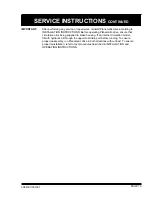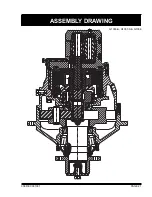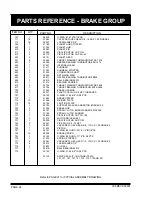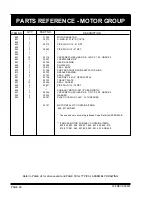
PAGE 12
PROBABLE CAUSE
FAILURE
GENERAL:
Typical Planematic drive operating problems are caused by a malfunctioning hydraulic system. Verify hydraulic
pressure and flow at the drive motor are as specified before dismounting or disassembling Planematic.
IMPORTANT:
Ensure that the hydraulic system reservoir is full and that the system pump is running at
full rpm before doing any system checks.
HYDRAULIC SYSTEM VOLUME AND PLANEMATIC SPEED:
The Planematic output speed depends on the hydraulic flow supplied to the drive motor. Maximum output speed
and required hydraulic volume appear in the SPECIFICATIONS section of this manual. If the Planematic does
not rotate at desired output speed, install a flow meter at the drive motor forward port. Fully open control valve
and measure hydraulic flow. Verify hydraulic operating volume as specified.
HYDRAULIC SYSTEM PRESSURE AND PLANEMATIC TORQUE:
The Planematic output torque depends on the hydraulic pressure supplied to the drive motor. Maximum output
torque and required hydraulic pressure appear in the SPECIFICATIONS section of this manual. If the Planematic
does not produce desired output torque, install pressure gauges at both drive motor gauge ports. Stall the drive,
fully open control valve and measure hydraulic pressure at motor ports. Verify hydraulic operating pressure and
maximum allowable motor return port back pressure as specified.
Sources of potential hydraulic flow and/or pressure loss include the hydraulic pump, relief control valves and
slipping belts on a v-belt driven pump.
If the hydraulic volume and pressure are per specification, refer to the following TROUBLESHOOTING chart to
identify failure probable causes.
TROUBLE SHOOTING
Drive will not produce maximum rated torque as
listed in SPECIFICATIONS.
a)
Hydraulic system supply pressure or back pressure not
per SPECIFICATIONS. Refer to procedure described in
TROUBLE SHOOTING - HYDRAULIC SYSTEM
PRESSURE AND PLANEMATIC TORQUE to verify
system pressures.
b)
Damaged or worn hydraulic motor.
a)
Hydraulic system supply volume, supply pressure or back
pressure not per SPECIFICATIONS. Refer to procedures
described in TROUBLE SHOOTING - HYDRAULIC
SYSTEM VOLUME AND PLANEMATIC SPEED and
HYDRAULIC SYSTEM PRESSURE AND PLANEMATIC
TORQUE to verify system pressures and volumes.
b)
Damaged or worn hydraulic motor.
a)
Leaking brake piston O-ring. Both piston O-rings must
seal to develop hydraulic brake release pressure.
b)
Leaking brake release pressure port O-ring. O-ring is located
on the motor adaptor and seals release oil pressure at the
brake housing. Failure of this O-ring results in significant
leakage between the motor adaptor and brake housing.
c)
Hydraulic brake release pressure not per
SPECIFICATIONS. Gauge release pressure at external
brake release port on motor adaptor.
d)
Plugged brake release pressure port. Hydraulic passages
in the motor adaptor and brake housing must be clear to
allow oil passage to reach brake piston.
338 REV.990801
Drive will not produce rated speed or rpm as
listed in SPECIFICATIONS.
Drive will not reverse (brake will not release).





























